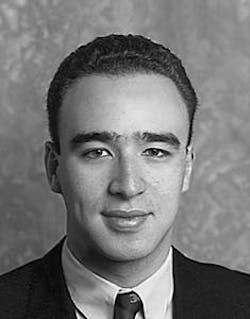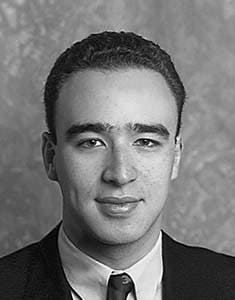Unconsolidated sand grain shape, size impact frac-pack design
Edouard Wang, Mukul M. SharmaThe shape and size of sand grains, as well as the saturating fluid, influence the mechanical properties of unconsolidated sands and need to be considered in frac-pack design.
University of Texas Austin
These mechanical properties of unconsolidated sands play an important role in determining the geometry of frac-pack treatments.
Stress-strain curves obtained for unconsolidated sands at elevated stresses show highly nonlinear hysteretic behavior. The impact of these findings on frac-pack design can be significant.
The nonlinear elastic properties of unconsolidated sand can give rise to some unique features in the pressure response and in the fracture geometry that may not be observed in hard rocks.
Frac packs
Fracturing of high permeability, lightly consolidated or unconsolidated sands is increasingly common for sand control.
Fracture models traditionally designed for treating hydraulic fracturing problems in hard rocks have been applied to frac packs. While the essential physics of both problems is the same, there are substantial differences that arise due to two reasons:
1. Large fluid leakoff to the formation2. Significantly different mechanical behavior of unconsolidated sands.
The fluid-loss behavior in high-permeability sands has been studied extensively and is well documented in a recent study by McGowan and Vitthal.1 This article focuses on the impact of mechanical properties of poorly consolidated and unconsolidated sands on the geometry of frac packs.
Mechanical properties
Relatively little data are available on the mechanical properties, such as stress-strain curves, of unconsolidated sands at elevated stresses.
The mechanical behavior of sands at such low stresses may not be representative of reservoir stress behavior. An extensive experimental program was undertaken to measure the stress-strain curves of unconsolidated sands at reservoir stresses. The detailed results were presented by Wang, Sharma, and Podio.2
Measurements were made at hydrostatic confining pressures of 2,000 psi and 4,000 psi. An additional axial load was exerted on the samples. This load varied from 0 to 2,500 psi. Both the axial and radial deformations as well as the pore compressibility were measured.
Fig. 1 [37410 bytes] shows a typical stress-strain curve. The following important features are evident:
- The stress-strain curves are nonlinear, implying elasto-plastic behavior.
- Residual strains are present, implying plastic deformation or grain rearrangement as the effective stress is increased.
- Hysteresis is consistently observed during stress cycling.
- As discussed later, all these features can play an important role in determining fracture geometry.
The extent of hysteresis and nonlinearity is a strong function of the following factors:
- Effective stress
- Saturating pore fluid
- Grain size and shape.
The hysteresis loops are larger and more square, resulting in rather abrupt changes in Young's modulus when the sample is loaded or unloaded beyond a point. No residual strains are observed in the small loops.
Replacing water by air as a saturating fluid leaves the elastic constant virtually unchanged but dramatically decreases the amount of hysteresis, resulting in flat loops in which the Young's modulus does not change as much.
Young's modulus
Fig. 1 suggests that purely elastic models for describing sands may be inappropriate. However, because all common fracture models assume linearly elastic rock behavior, it is important to specify a number for the apparent Young's modulus.
Consider a fracture being created in an unconsolidated sand as shown in Fig. 2 [21366 bytes]. It is instructive to construct the stress profiles and the stress history seen by different parts of the reservoir during this fracturing process.
In the case of a formation with a small hydraulic diffusivity, a (representative of oil-bearing zones) where a = fmC/k, Fig. 3a [40435 bytes] shows this pressure variation along an axis perpendicular to the fracture face at different times. Fig. 3b [40435 bytes] shows this pressure variation for a gas well with a high hydraulic diffusivity. These pressure profiles are obtained by solving the diffusivity equation.
Assuming a uniform minimum horizontal stress sH,min, we can then construct the variation of the net (or effective) stress acting on the sand matrix.
The effective stress seen by sand grains at or near the fracture face would then decrease with time as the frac fluid pressure is increased. This would correspond to going down on the unloading arm of our stress-strain curve shown in Fig. 1, Points A to B.
As the sand is unloaded, the Young's modulus will change from a large value, in the order of 5 million psi, to a much smaller value, in the order of 1 million psi. The resulting Young's modulus distribution behind the fracture wall can be derived and is given in Fig. 4a [36254 bytes] for the case of oil and in Fig. 4b [36254 bytes] for the case of gas.
How far the fluid pressure will propagate away from the fracture face will of course depend on the fluid loss and the compressibility of the pore fluids.
For highly compressible pore fluids, the pressure may not propagate very far and the sand may not be unloaded very far from the fracture face. However, for relatively incompressible fluids the pressure wave will propagate quickly into the matrix, unloading the sand grains and result in significantly lower Young's moduli for a large part of the reservoir away from the fracture face (Fig. 5 [19519 bytes]).
This suggests that the region immediately surrounding the fracture will consist of unloaded sand (low effective or intergranular stress) which has a small Young's modulus, followed by a region of the sand that is highly compacted and has a much higher Young's modulus.
Fracture growth in such inhomogenous media is determined by the elastic moduli of both the soft region surrounding the crack and the outer region of higher Young's modulus. While the solution for such a problem is quite complex, some limiting cases can be used to describe qualitatively the behavior of fracture growth in such unconsolidated media.
In the case of high fluid leakoff and relatively incompressible pore fluids, the pressure will penetrate deep into the formation, and the problem can be modeled as one in which the Young's modulus of the sand corresponds to the softer material, in the order of 200,000 psi.
In the case of small fluid leakoff and highly compressible fluids, the pressure will not penetrate very far from the fracture face, and it may be more appropriate to use the higher value of the Young's modulus, in the order of 3 million psi.
This unique feature of unconsolidated sands, where Young's modulus and Poisson's ratio vary systematically with the effective stress, results in a coupling between fluid-loss behavior, fluid compressibility, and mechanical rock properties. Such a coupling does not exist in fracture design for hard and consolidated rocks because the elastic moduli do not depend on the effective stress to such a large degree.
It is, therefore, evident from this discussion that use of elastic moduli from the unloading part of the stress-strain curve shown in Fig. 1 are appropriate for frac-pack design. Furthermore, because fluid loss will often be high in poorly consolidated formations of high permeability, it may be more appropriate to use the lower values of Young's modulus (200,000 psi).
In general, the Young's moduli used from the unloading curve will depend on the penetration of the frac-fluid pressure away from the fracture face.
Shear failure
The fluid leakoff during a fracture treatment in a weak rock such as an unconsolidated sand can be critical for the geometry of the fracture. Indeed an increase in pore pressure could cause shear failure at the fracture wall, resulting in reduced fracture conductivity and erratic fracture geometry and pressure.
Consider two cases of low and high leakoff:
In the limit where no leakoff occurs due to the presence of an impermeable cake on the fracture walls, the pore pressure of the rock behind the fracture wall remains slightly above reservoir pressure Pr, while the fracture is at the fracture injection pressure Pi.
The element of rock behind the fracture wall sees an increase in horizontal stress due to the presence of the fracture and no change in both vertical stress and pore pressure. Shear failure is not likely to occur, as the stress contrast has been reduced.
When fluid leakoff is high, the pore pressure behind the fracture wall is elevated to be close to Pi. The rock deformation due to the fracture induces an increase in horizontal stress, as it did in the no leakoff case. However, this time, the pore pressure is raised from Pr to Pi, reducing all three principal net stresses.
This last factor, combined with the low cohesive strength of the sand, could cause shear failure at the fracture walls.
The Mohr Coulomb criterion for shear failure can be used as a simple approximation for failure in granular rocks (Fig. 6 [19209 bytes]). A circle is drawn such that sv and sh lie on one of its diameters. If the circle remains below the failure envelope, no failure occurs, but if the circle intercepts the envelope, then failure occurs. The condition for shear failure of rocks can be represented mathematically by Equation 1 (see equation box).
In Equation 1, sv and sh are the vertical stress and the minimum horizontal stress, respectively. The a, Biot's constant, is set equal to 1 for our calculations. The intrinsic strength or cohesion of the rock, S0, is usually very low for poorly consolidated sands. The f is the internal angle of friction.
Pf is the pressure at the fracture wall, a very short distance inside the rock matrix, and for all practical purposes, the pressure inside the fracture at this distance from the well bore.
Equation 1 provides an upper limit for Pf after which shear failure will occur. However, to propagate a fracture, Pf must also be greater than sh, the minimum horizontal stress. Considering this and Equation 1, we obtain Equation 2.
Equation 2 provides a pressure domain over which the fracture wall will not fail as the fracture propagates. Above this pressure range, shear failure occurs, and below it, the fracture cannot be sustained.
Examples of acceptable pressure domains inside the fracture are plotted in Fig. 7 [41419 bytes] for two different rock cohesion strengths, S0. This number is in the order of 200 to 1,000 psi for poorly consolidated rocks.
It appears that, depending on the internal angle of friction, f, and the vertical and horizontal stresses, the acceptable pressure range can be quite narrow, and even non existent for low values of f (Fig. 7 [41419 bytes]).
The narrow pressure range over which shear failure can be averted indicates that shear failure is likely to happen in frac packs.
Shear failure at the fracture face could have several adverse consequences for the fracture treatment. Such failure could result in a local collapse of the fracture, with partial closure of the fracture opening, resulting in a reduced fracture conductivity. Also, detached sand grains could mix with the flowing proppant and reduce the fracture conductivity. Finally, a shear failure would modify the stress field around the crack, invalidating the fracture growth models used to predict its geometry.
It appears that reducing leakoff as much as possible when fracturing a sand of low cohesive strength will reduce the likelihood of shear failure and will, therefore, be very beneficial to the growth and conductivity of the fracture.
Effective treatments
Hydraulic fracturing in unconsolidated sands has unique problems that must be addressed to optimize the effectiveness of the treatment.
The mechanical properties of sands are altered during the fracture treatment due to unloading of the rock caused by fluid leakoff. This results in the creation of a soft zone in the vicinity of the fracture face which has a lower Young's modulus than the native unaltered reservoir rock.
In most cases, it is appropriate to use the smaller value of the Young's modulus from an unloading cycle on the stress-strain curve. E values of 0.2 to 3 million psi seem appropriate based on our data. The reliability of the minifrac test is limited for these formations because it is likely to overestimate the Young's modulus by one order of magnitude.
Finally, it is important to reduce fluid leakoff as much as possible to avoid shear failure at the fracture walls. Shear failure is likely to take place in formations which have very little cohesive strength and could be detrimental to the fracture conductivity.
Acknowledgments
The authors would like to thank Tony Podio and John Olson of the University of Texas at Austin for their help and insights. We would also like to thank the sponsors of the stimulation, logging, and formation damage program at the University of Texas at Austin.
References
1. McGowen, J.M., Vitthal, S., "Fracturing Fluid Leakoff Under Dynamic Conditions, Part 2: Effect of Shear Rate, Permeability and Porosity," Paper NO. SPE 36493, Annual Technical Conference and Exhibition, Oct. 7-9, 1996.
2. Wang, E., Sharma, M., and Podio, A., "Mechanical Properties of Unconsolidated Sands at Reservoir Stresses," submitted for publication to SPE Journal, 1997.
The Authors
Edouard Wang is now working as an engineer for Shell France. Wang has a BS from Ecole Centrale de Lille and an MS in petroleum engineering from the University of Texas at Austin.
Mukul M. Sharma is a professor of petroleum engineering at the University of Texas at Austin. His current research interests include petrophysics and formation damage. Sharma has a Bachelor of Technology in chemical engineering from the Indian Institute of Technology and an MS and PhD in chemical and petroleum engineering from the University of Southern California.Copyright 1997 Oil & Gas Journal. All Rights Reserved.


